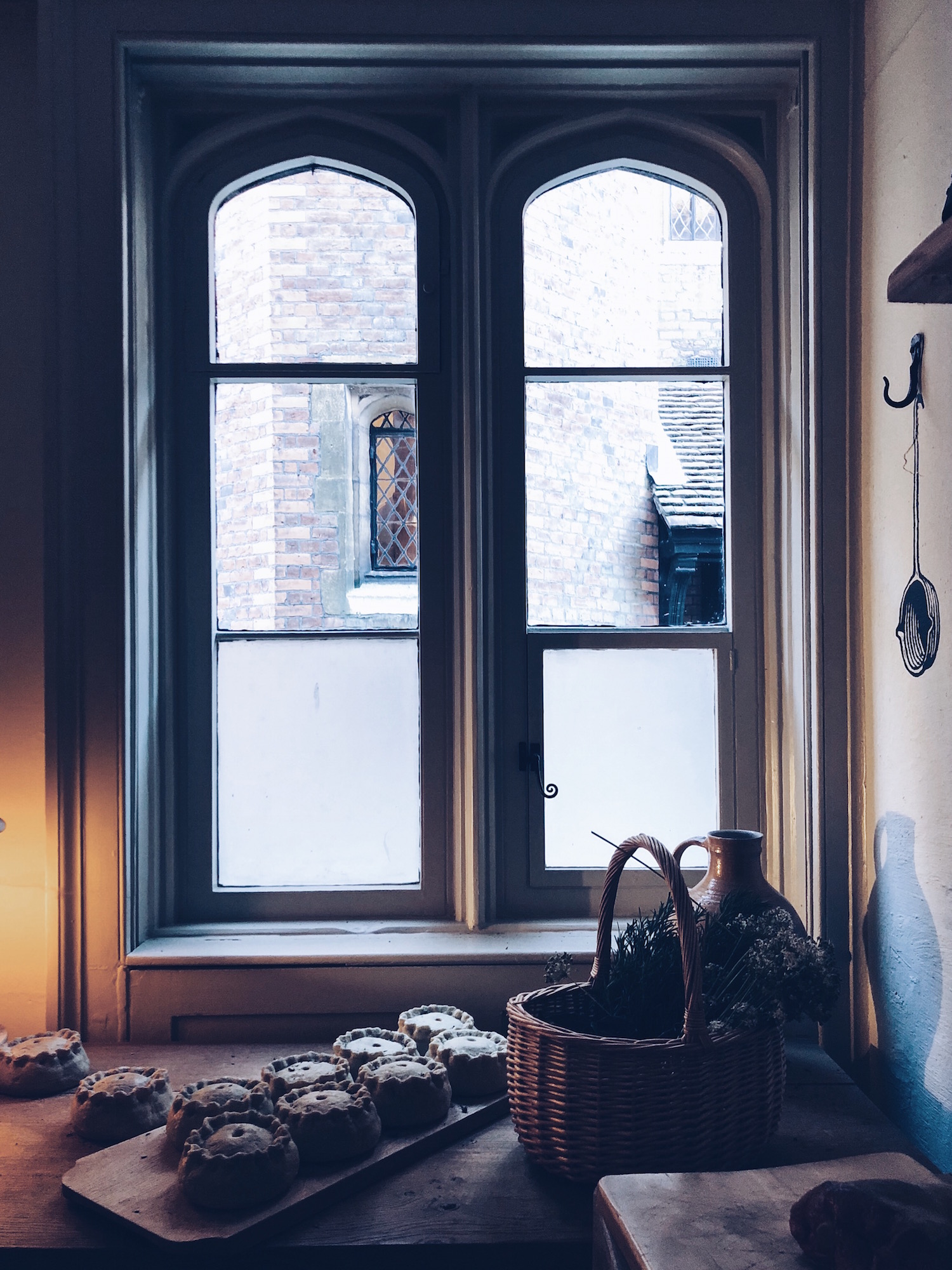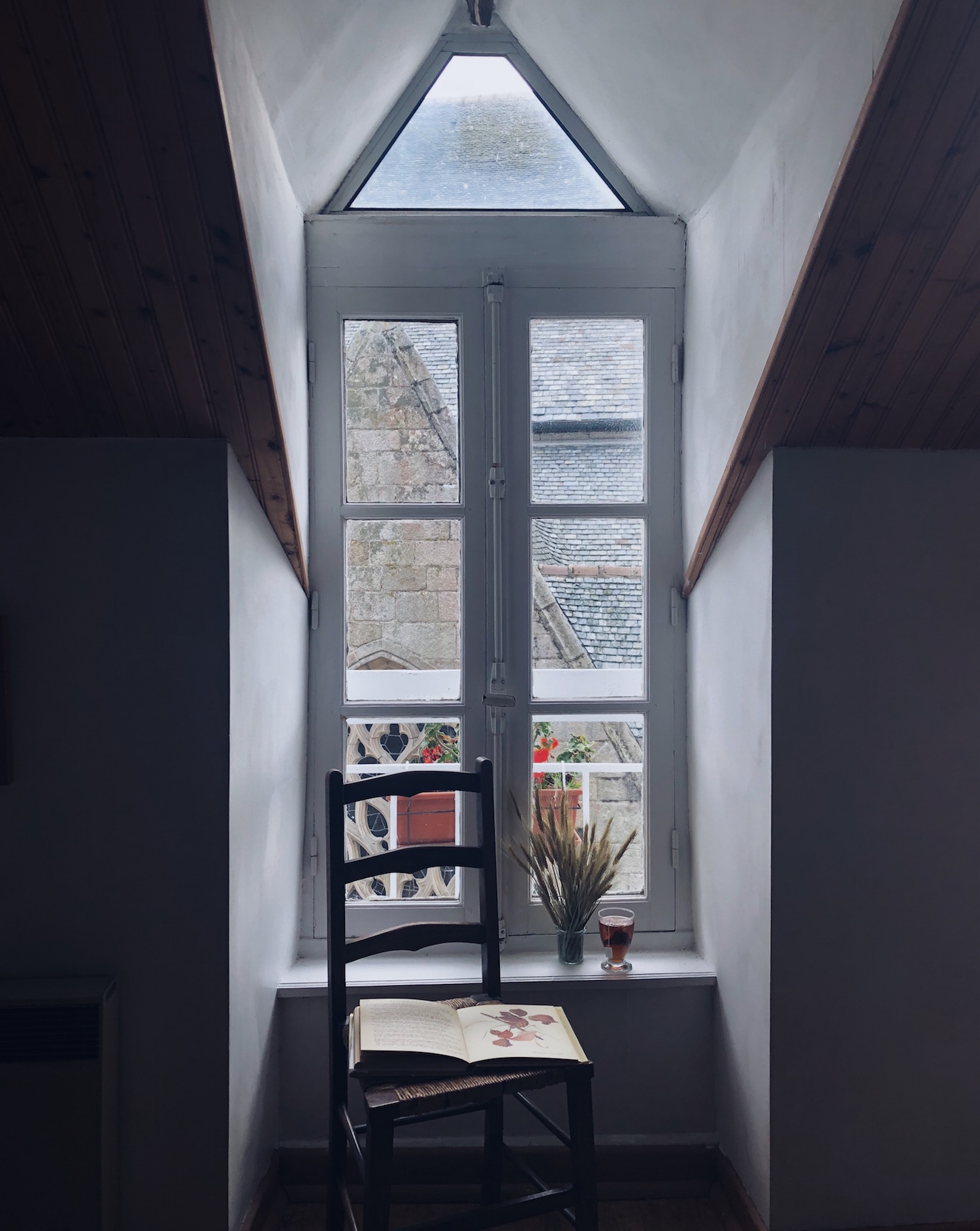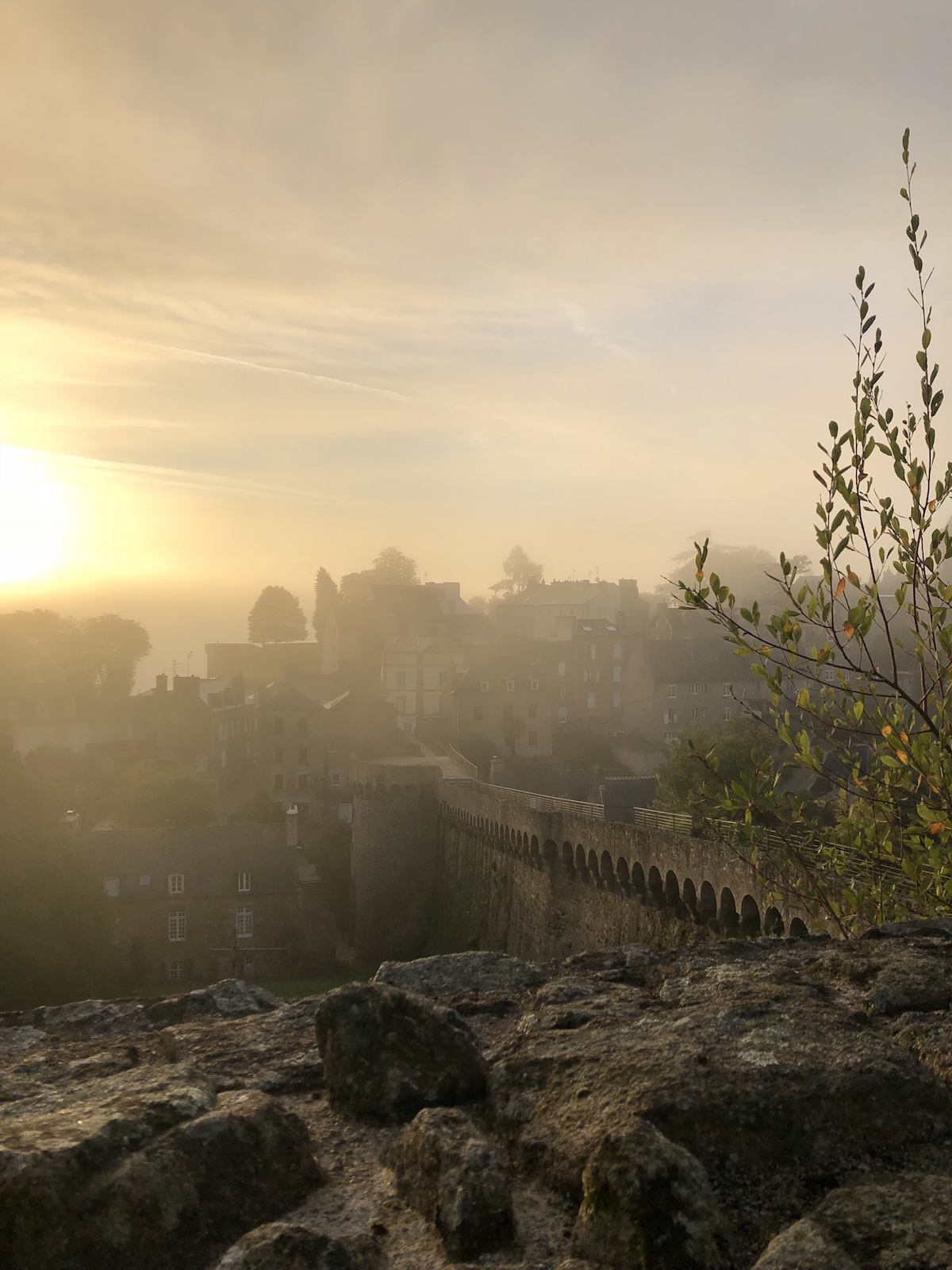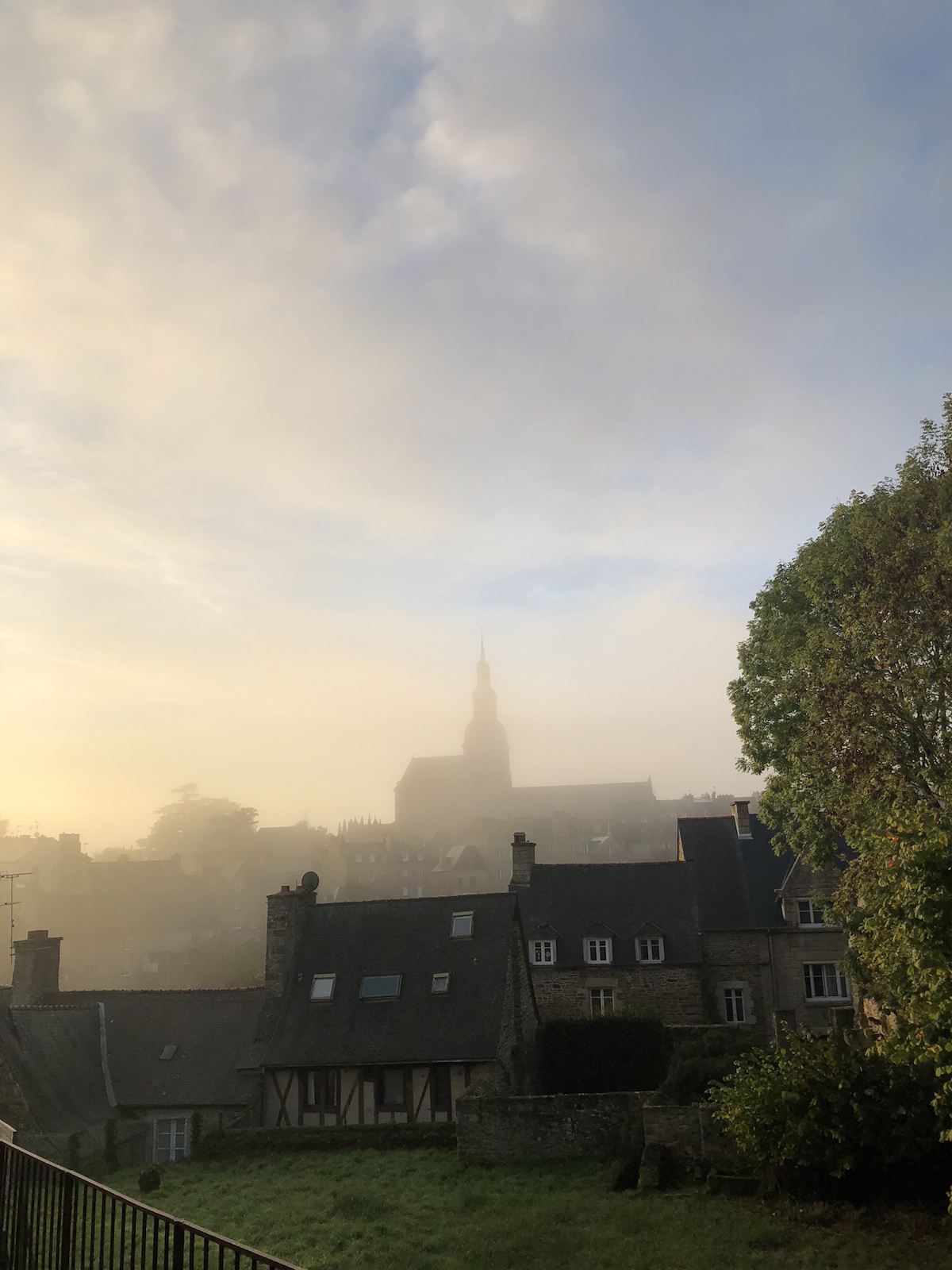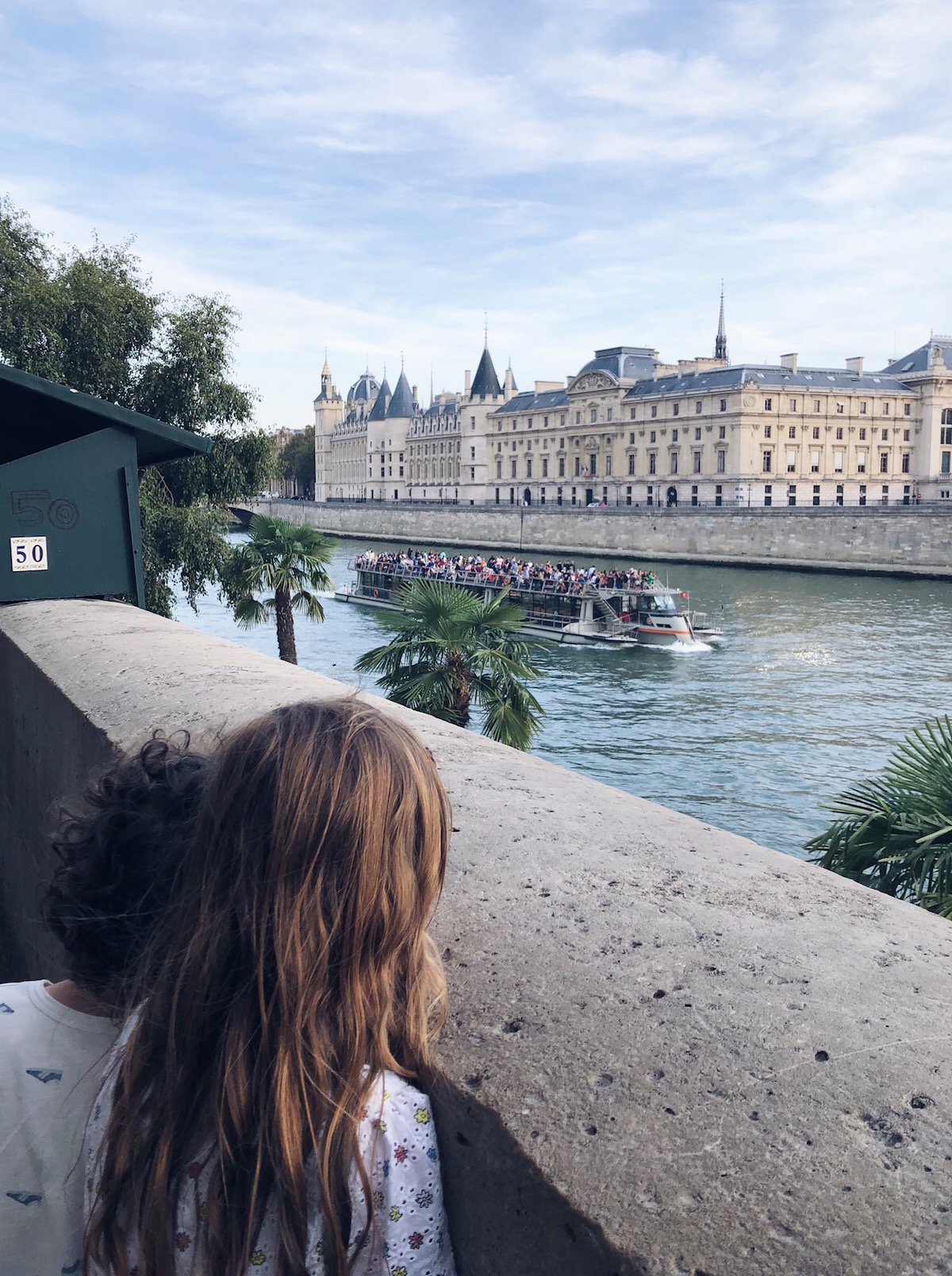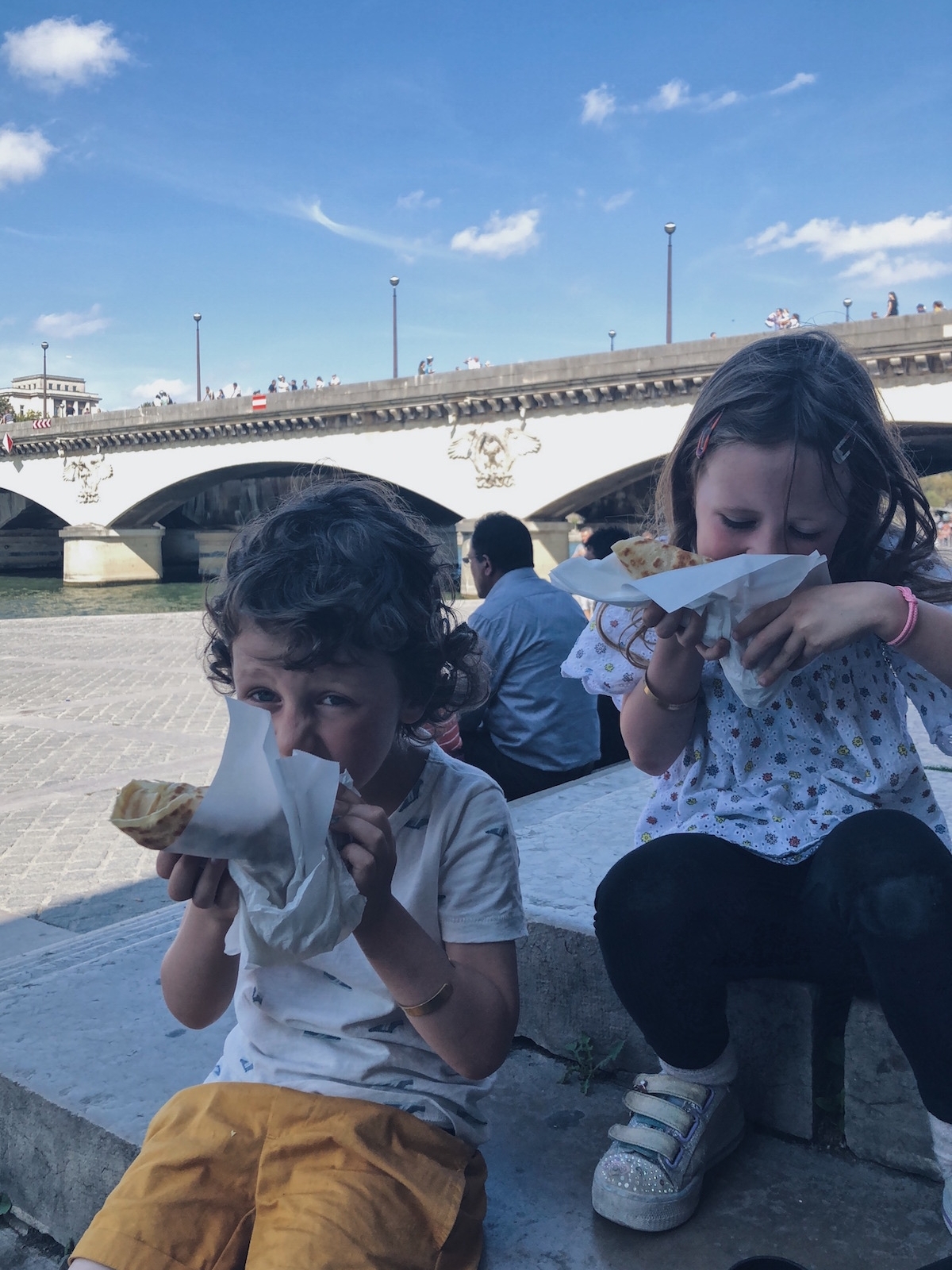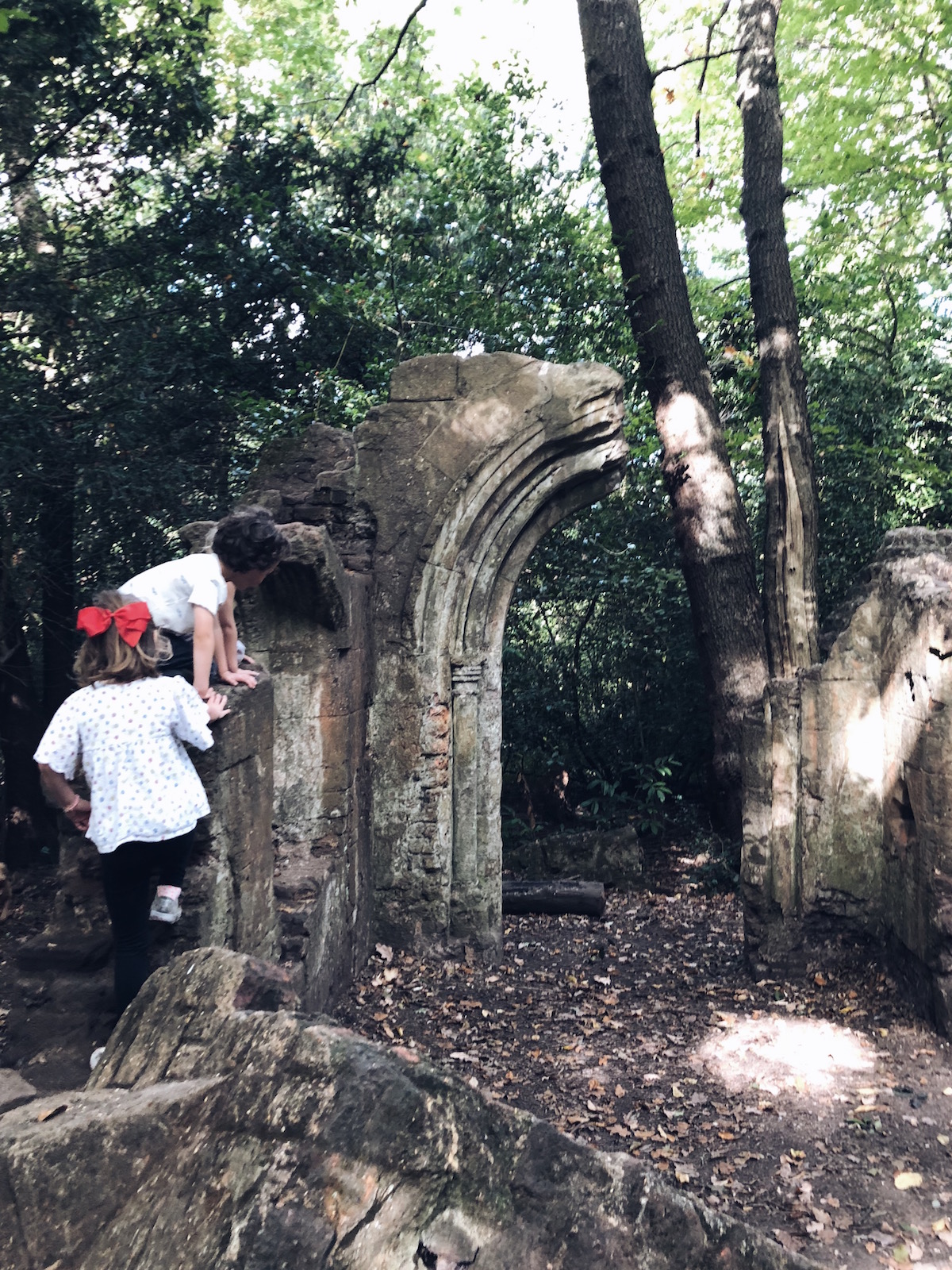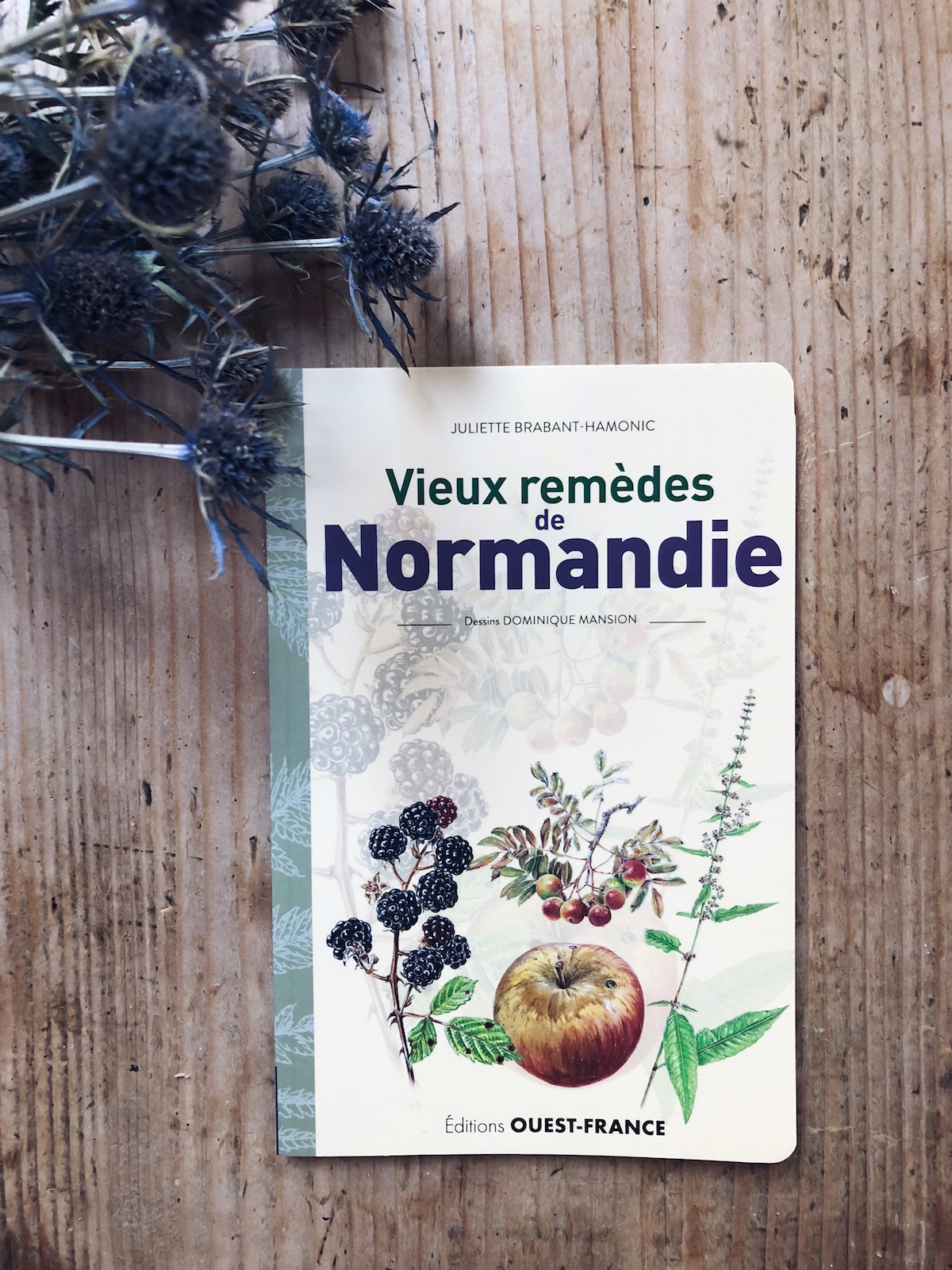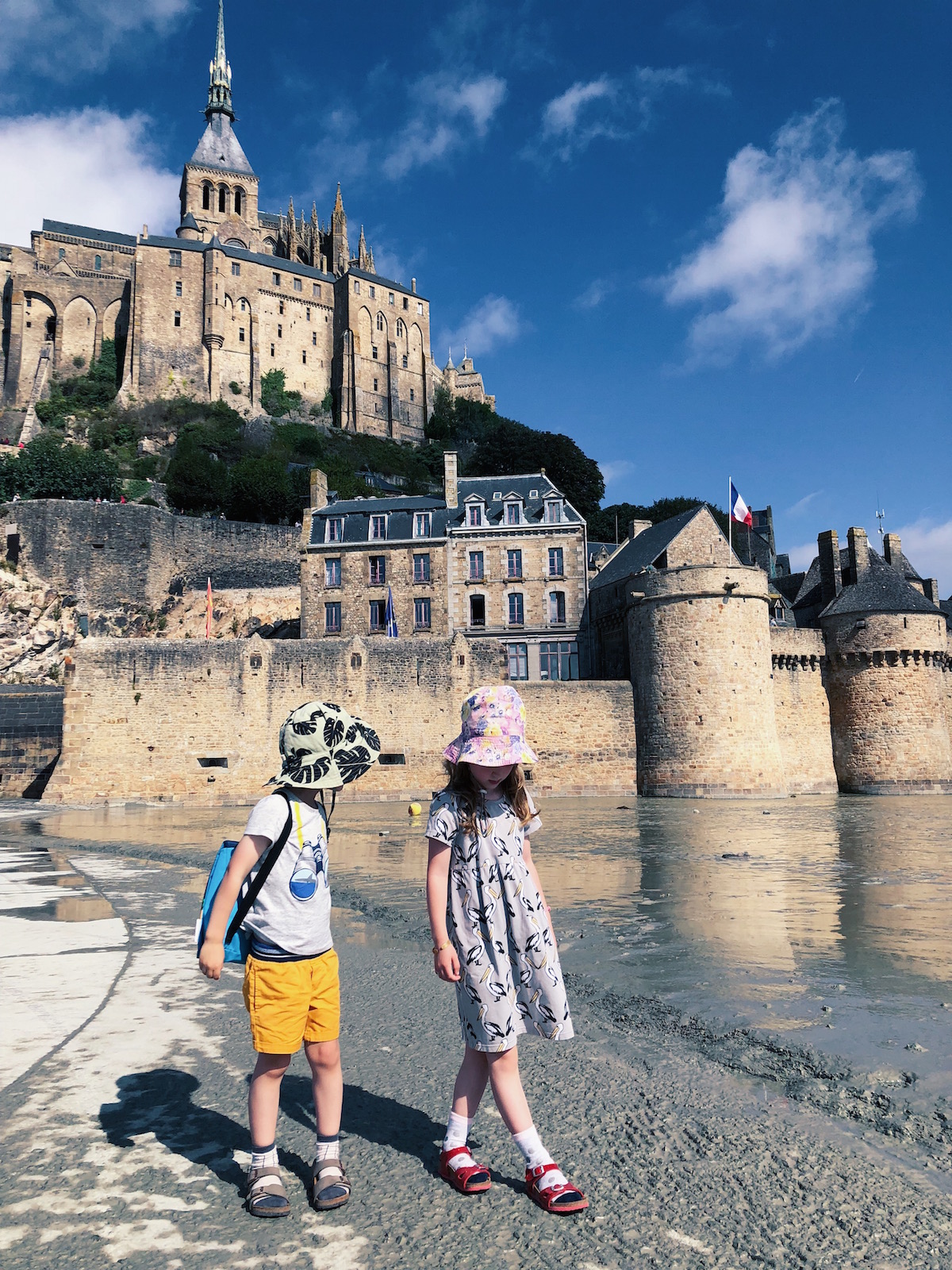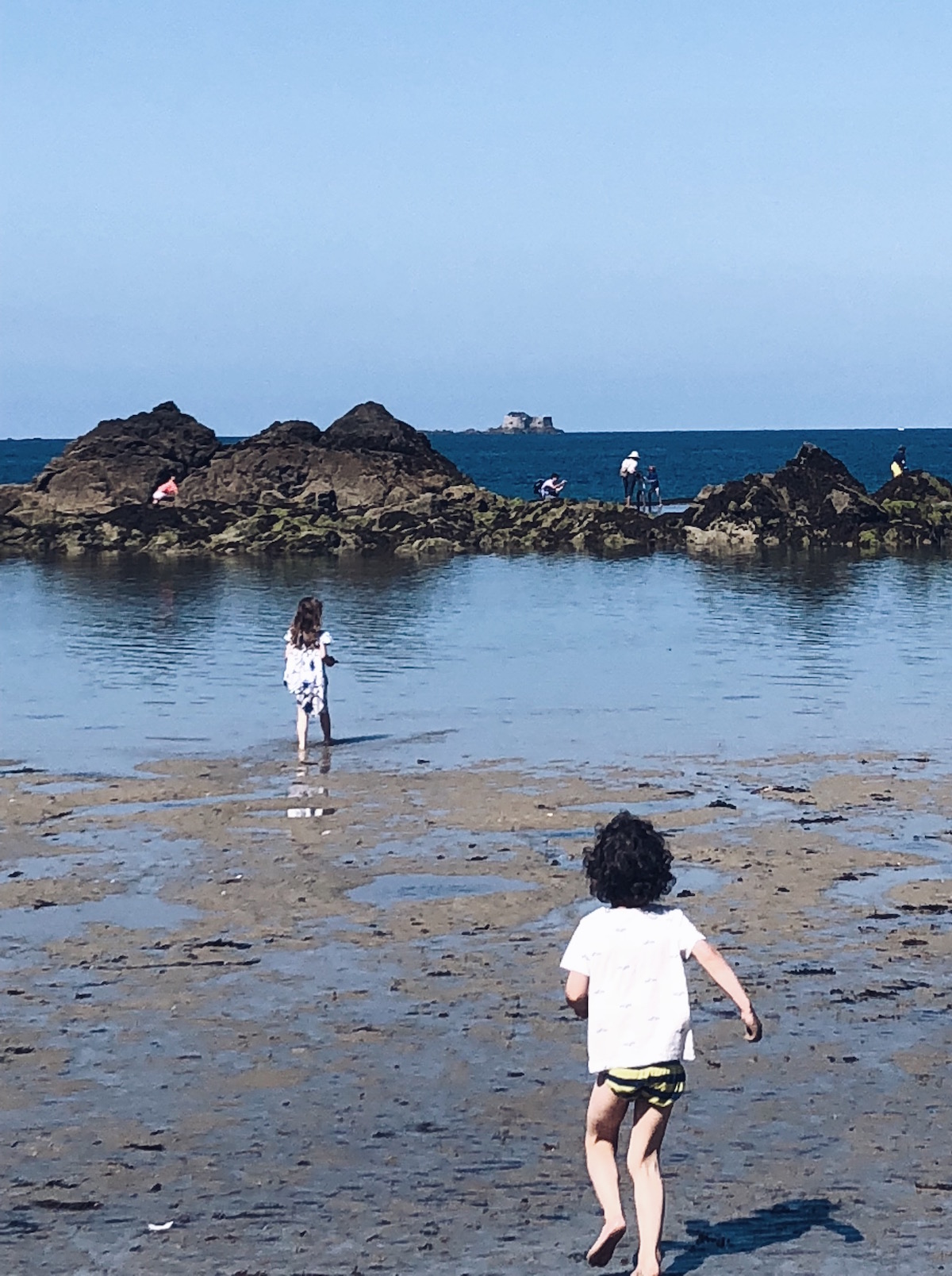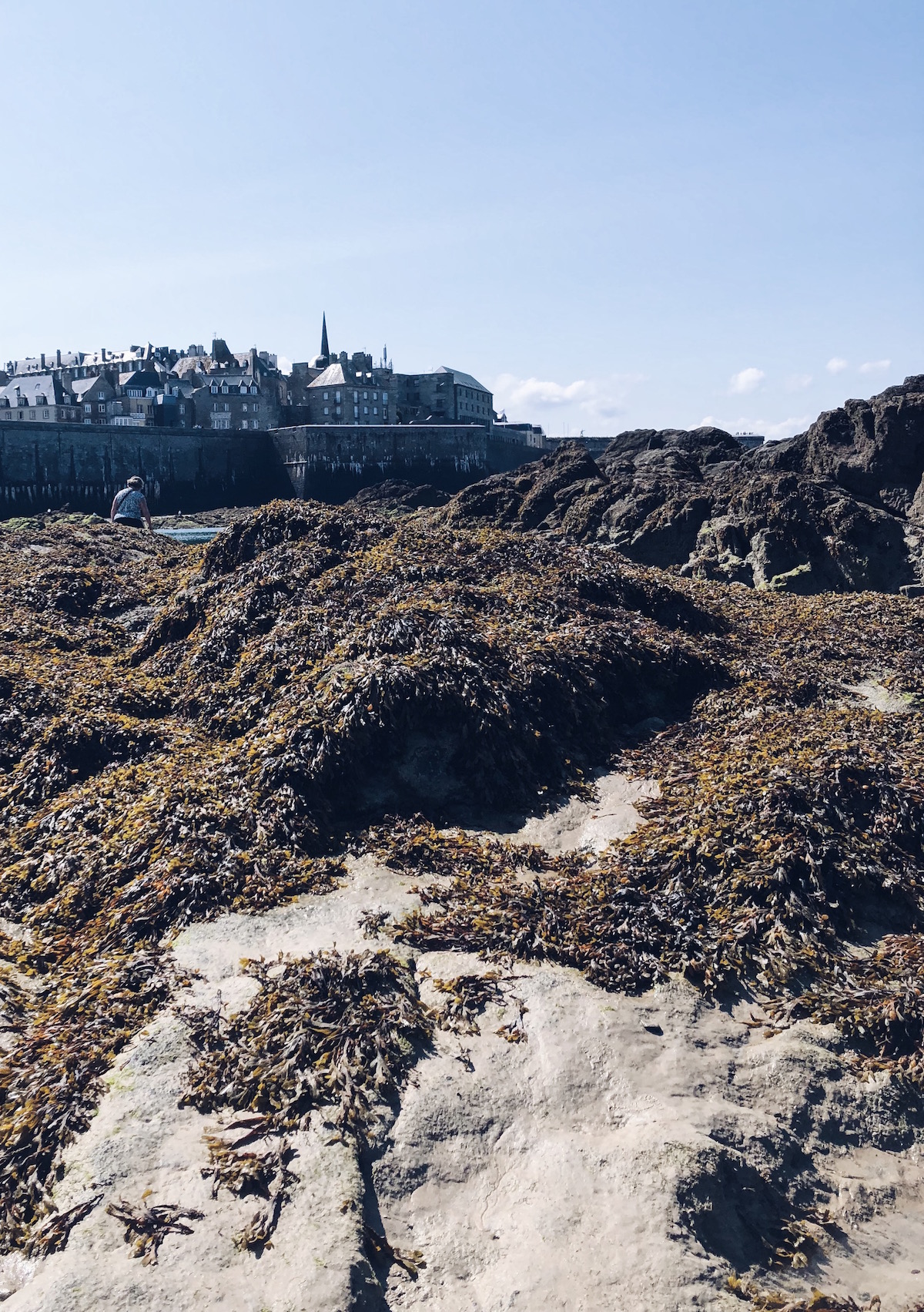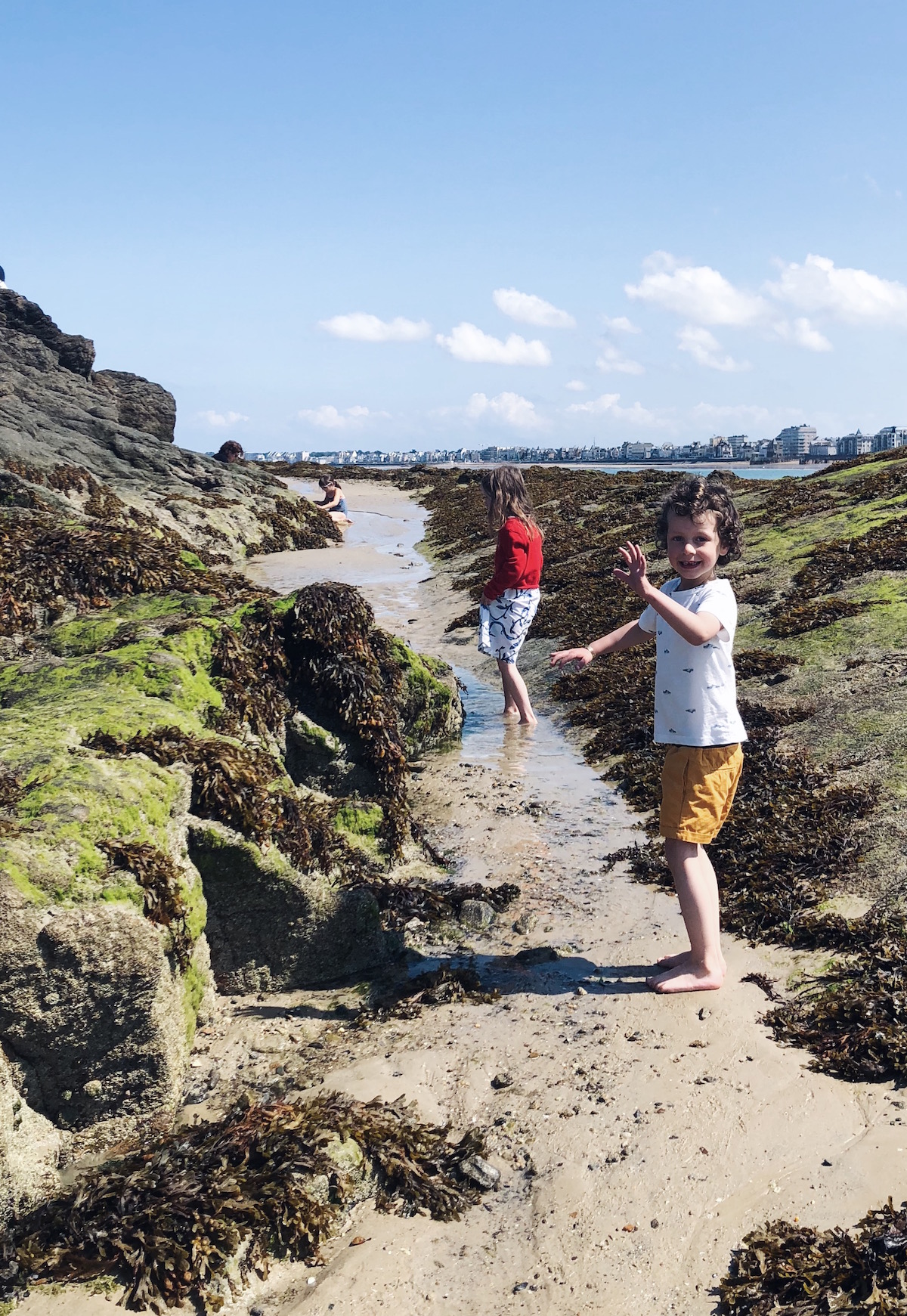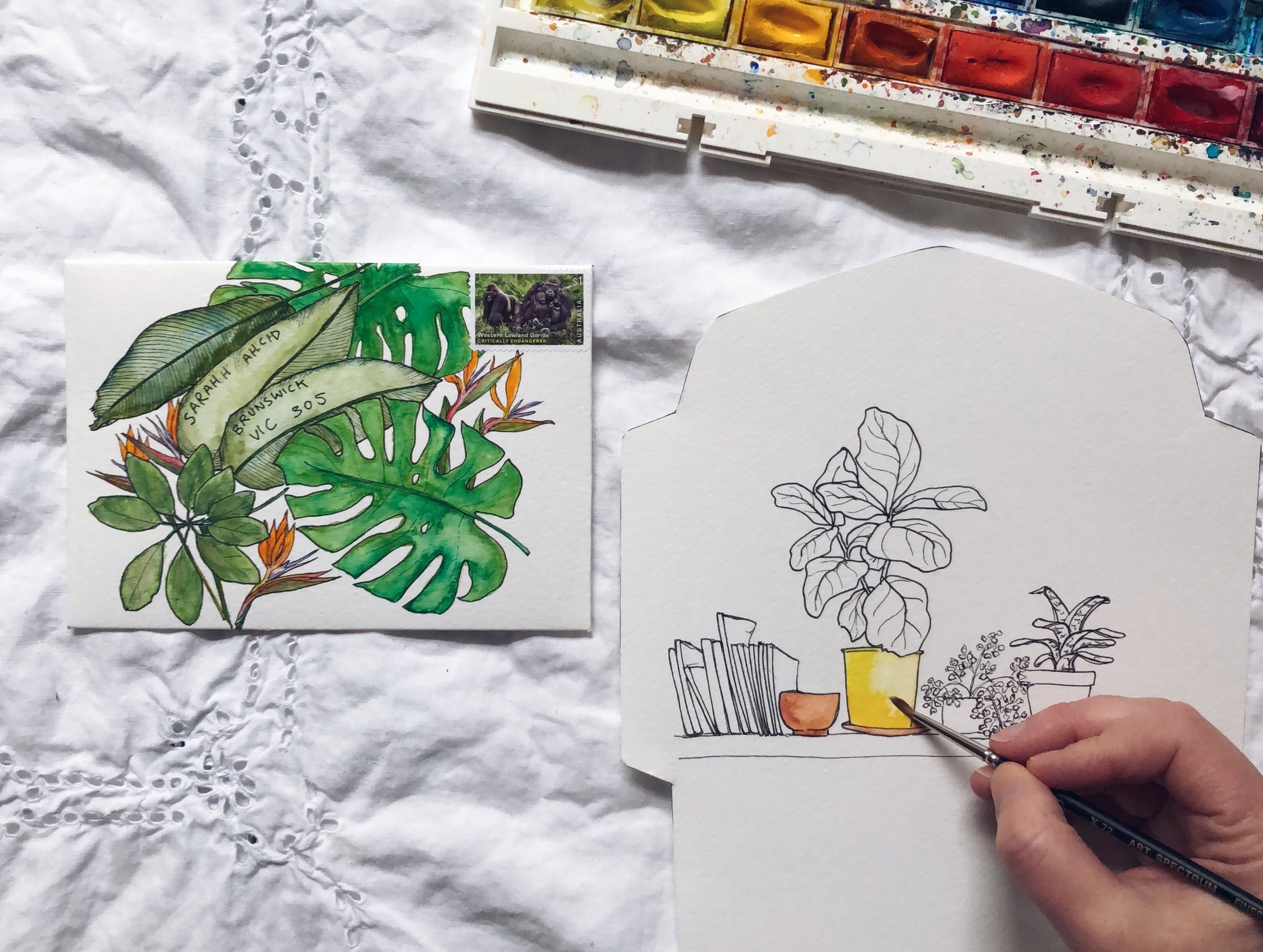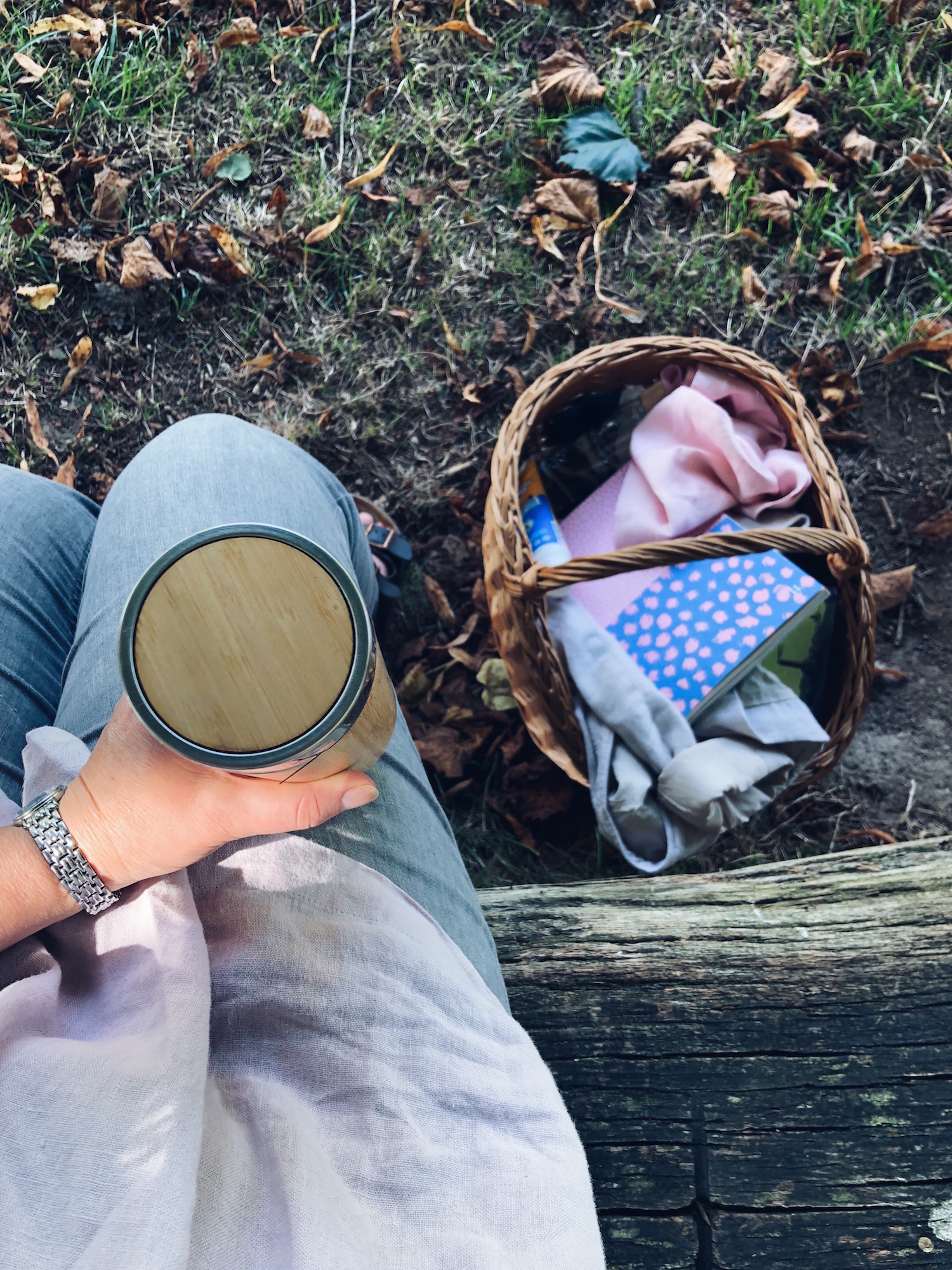
JOURNAL
documenting
&
discovering joyful things
All the light we see
As the days grow shorter I find I am following the light around our little apartment, seeking moments of calm in a sun that illuminates but does not burn. In the afternoon, the light slants through the dormer windows and over the table where I paint, creating patterns and shadows that are as real as they are transient, and breathtakingly beautiful.
I sit by the window and make notes in the little ‘field notes’ notebook with a blackbird the cover that I picked up at the Horniman Museum gift shop when we were in London in September. As for so many other people at this time of year (maybe you?), my thoughts are turning to introspection, a kind of ‘life stocktake of 2018’, if you like, alongside all my hopes, dreams and plans for 2019.
When it comes to ‘hopes, dreams and plans’, the key challenge I find is deciding where to put my energy. I have been guilty (and I’m sure I’m not alone here!) of taking on way too much. And as I don’t like to do anything half-hearted, I throw myself into all the things and all too often end up exhausted, burnt out, and unable to be present for my family in the way I want to be.
Do you relate?
Certainly, the first half of this year looked like that, but this extended stay in France has helped give me the mental white-space I’ve needed to see things with a little more clarity.
For example, with the clarity of emotional distance, I can look on our French sojourn as the cumulation of all those missed holidays and breaks. Aside from one week in Tasmania 18 months ago, I have not taken a break since I fell pregnant with my daughter in 2011. I worked up until the day before both of my children were born, and was back at work when my daughter was only six weeks old, and my son only three weeks old.
Of course, I work from home, so it’s not as though I’ve been in the office for all that time, and my hours equate to part time. But working from home means it’s almost more difficult to switch off, and the lines between work and family blur even further. And the rest of the time is taken up with those not-insigificant hours of cleaning, cooking, administering and nurturing to my little family. As much as I enjoy work and parenting none of it feels like a break!
This stay in France has been like a recuperation period, a chance to finally stop and rest and reflect and play. If I’d been sensible and taken two or three weeks a year during the past six years for holidays, they would have added up to the same amount of time out, but maybe just maybe, I could have avoided the sense of overload and overwhelm I’d been experiencing in the lead-up to this trip. (I suspect there’s a lesson in there for me somewhere.)
So now I sit by the window in the weakening light and sip my tea, and make notes in my blackbird notebook. Everything I’ve been doing, work-wise, this year. What’s working for me, and what isn’t. What feeds my soul and supports my family, and what detracts from soul or family (or both).
And I write down all those plans. So many creative dreams, all of which I am eager to sink my teeth into. Finally releasing that snail-mail book. A podcast about meals in the mail. Another colouring book. An illustrated year-book. A collaboration on sustainability that I’ve been invited to take on. A charity cook-book. Weekend intensive workshops for students. Postcard and zine projects. Stationery kits. Seed packets. Finally learning pottery. And how to crochet.
My first instinct is to take on ALL the plans, and pile them on top of everything I’m already doing. But in the calm and quiet sunshine of this much-needed time out, I can see more clearly. Looking down at that notebook, I can see projects that I loved this year but that didn’t serve me or my family. I can see creative ideas that I know I’ll love but that won’t serve us in 2019.
Slowly, I am paring back and choosing favourites… and choosing health and family and joy as well as, well, sheer productivity.
It’s easy to see a holiday as a great indulgence. Maybe it’s a vestige of the Protestant Work Ethic, but both my husband and I find it hard to stop. If one of us doesn’t work at night after dinner, the other one exclaims in surprise, “Oh! No work tonight!” and within the celebration of freedom there’s also an unspoken undercurrent of, “Must be nice to lead such a leisurely life.”
It’s time to reset. We both need to stop glorifying ‘being busy’.
Instead, I want to structure my days like the farmers of old. Work hard all day. Stop for a proper lunch to gain sustenance and energy for the afternoon ahead. After dinner, enjoy a well-earned rest: read a book, paint, watch TV, play board-games, write letters, crochet… in other words, leisure. Earmark at least one day each weekend for family and no work.
And once a year, while the earth sleeps (aka quieter times at work), take a break. Nothing necessarily as grand or expensive as an overseas trip (although wouldn’t that be lovely!), but ensure a deliberate, physical separation from work and obligations, to rest and reset.
These thoughts are all scribbled down in my notebook, in jumbles and pieces side-by-side with shopping lists and plant-doodles and wifi keys from the various places we’ve stayed. As I read over them before the light fades, I realise I may be making changes in 2019, bigger than I’d anticipated, pivoting again. And it feels good to finally begin to see.
Just one thing: the inconvenience of saying no
Last year, I started writing intermittent blog posts about how I was trying to do “just one thing” to live in a more sustainable way, and take better care of our planet.
The idea of “just one thing” came about because the whole problem just seemed too big, and overwhelming, to navigate as a whole. Especially once I started to learn that recycling wasn’t the magic cure-all we had once believed it would be, and that the resources required to recycle our waste were enormous and (ironically) mostly-unsustainable.
So, rather than trying to fix everything at once, I tried doing one small thing at a time and, once that thing became habit, I started doing something else.
As time went by, I was proud to find that our previously-overflowing bin would go out each week with a lid that could actually close. I realise that’s not a big step for some people (in fact a full bin is worst-case, not best-case, for a lot of families), but it was a big achievement for us.
But one thing I’ve come to realise is just how much of what we buy comes in packaging that I then need to toss or recycle, so that bin does keep on filling up despite everything I’ve been doing. Right now, I’m just not in a place to be able to make all our own cosmetics and toiletries, for example, and store them in pretty glass jars, or repurpose our old tuna tins into bookends. But every time I buy these things, the packaging ends up in recycling or landfill.
You know the stuff I’m talking about: in the bathroom, we have toothpaste, deodorant, moisturisers, cleansers, shampoo, conditioner, body-wash, hand-soap, hand-cream, sunscreen, lip-salve, and all kinds of other rubs and scrubs. If you come with me into the office, there are glue-sticks and plastic pens and boxes of staples and bulldog-clips, all my paint tubes, plastic document-sleeves, printer ink cartridges, and on it goes. Under the kitchen sink, I do use bicarbonate of soda and vinegar for a lot of my cleaning, but you’ll still find washing up detergent, washing up gloves, and an enormous array of chemicals in liquid form that do all kinds of damaging things to our planet, stored in plastic containers.
It’s heartbreaking!
I think that our extended stay in France has really hammered home to me the extent of our household waste. First of all, because when we first arrived here, I had to buy just about everything from scratch. Cleaning supplies, hygiene supplies, and all those pantry-staples like oil and flour and rice… I had to buy all of them, and they all came in packaging. Secondly, we don’t have any compost in this apartment, and the only recycling is glass. So every day I can actually see all that cardboard and plastic I’m using. I still separate it out - old habits die hard - but then it all goes into the one big bin outside.
But by separating out the cardboard and plastic, and then throwing it all into landfill, I have been inadvertently sending myself a powerful message. I can actually see all of these things I am bringing into my home. Back in Australia, I toss them straight into the recycling, and they are much more easily forgotten.
And this brings me to my “just one thing” for today: saying no, even when it is inconvenient.
I don't really have the answer, just yet, and if you have any experience of this, I’d love your help! But I guess what I want to talk about today is being mindful not only of what we do with our waste once it becomes waste, but of what we bring into the house in the first place.
For example:
Could I buy less food, so we don’t throw out as much? (Could we get better, as a family, at eating leftovers even if we don’t feel like eating that again today?)
Could I buy more in bulk so that even if the container is plastic, it’s only one instead of five?
Could I do without some things from the supermarket, and wait until market day so that I can pick them up without packaging?
Earlier this year our family supported this successful crowd-funding initiative for reusable, glass bottles for our milk so, when we return to Australia, I’ll need to get good at picking up and returning our bottles from specific places
Could I get better and bringing my own containers to the butcher and tell them not to put my meat in any plastic or wax paper?
Could I bring my containers to the green-grocer and give them back the plastic containers for cherry-tomatoes and berries? Or if they can’t take back the containers, could I suck it up and just not buy cherry tomatoes or berries until I can get them from the market?
Could I bring my empty egg-containers back to the green-grocers, just as I do at the markets?
Confession: when I started writing this blog post this morning, I was thinking, “this one thing is too hard. I don’t have any good answers.” But as I’ve listed the ideas and questions above, I realise I was simply feeling overwhelmed. I know my ideas won’t solve everything, but surely they are better than doing nothing! All I need to do is be willing to accept a tiny bit of inconvenience in order to keep making the changes I so badly want.
I’d really love to hear what you do - I’m sure there are loads of things I haven’t considered!
Some other ideas
In the meantime, following are some of the other actions I have gradually been taking during the past few years to help reduce my footprint on this planet.
I share this list here in case it inspires you, or gives you ideas, but I do want to add in the caveat that I am doing these things one thing at a time, not always successfully and often with stops, starts and backslides. If you are new to the journey of sustainable living and this all seems overwhelming, I hear you! I encourage you to be kind to yourself, and to consider trying just one thing, either from this list or something else. (I’ve included a “how it helps” hint at each of the steps I’m sharing below, so you can see how even one little change in our lifestyles can make a big difference.)
On the other hand, maybe you are way ahead and have loads of other great ideas for how we can do “just one thing” to care for this planet a more mindful way. I’d really love to hear what you are doing, in the comments so everyone reading can benefit from what you’ve learned.
We each have to walk our own paths according to our own beliefs, budgets, family circumstances, family pushback to making changes (!), available time… so I guess I just want to say that there is zero judgement here (and honestly, very limited success on my part), and all I hope is that this list will kick-start ideas or conversations. OK, here’s where I’m at so far:
Taking my own carry-bags shopping, instead of accepting plastic bags. At first I forgot a lot, but now it’s habit. (How it makes a difference: if everyone in Australia refused just ONE plastic bag at the supermarket, there would be 24.6 million less plastic bags that go into landfill)
Seeking composting solutions that work even though we only have a tiny garden. So far I’ve really liked this composting cannon, but I’m considering upgrading to something that will accept more of our organic household waste. (How it helps: I am guilty of previously thinking, “Oh, but food waste breaks down, so it’s fine.” Turns out, food waste creates methane gas, which is 25 times more damaging to the environment than carbon dioxide. If everyone in Australia composted only 10 percent of their uneaten food, we’d be keeping 330,000 tonnes of rotting, gas-producing waste out of landfill)
Using reusable cups for my take-away coffee (or in France, only drinking coffee at cafes). I have an assortment of reusable cups at home: the classic reinforced glass cup, one that’s a thermos inside so my coffee stays hot for longer, and a beautiful stoneware mug with a removable lid. (How it makes a difference: reduces landfill and resource-waste. Despite ‘feeling’ like cardboard, more than 99 percent of disposable coffee cups are not recycled because of the plastic lining that makes them heat- and moisture-proof)
Replacing my use of soft plastic, like cling-wrap, with reusable beeswax wraps. I use them to cover bowls in the ‘fridge, keep cheese fresh, wrap up sandwiches for picnics and lunch boxes… they are great for practically anything, as long as you don’t use them with meat (because they can only be wiped down to clean) or anything hot (because beeswax melts!). (How it makes a difference: cling-film goes into landfill and recently I read that more than 1.2 billion metres of cling film was being used by households in Britain alone, every year, enough to circumnavigate the entire planet 30 times over)
Stop buying bottles of sparkling water. We did buy a soda-stream instead, but basically we have taught ourselves to drink still tap-water at home. (Groundbreaking, I know. What ridiculously privileged lives we lead!) I also carry a lovely, reusable drink bottle with me when I’m out and about, so I never have to buy bottled water for myself or the kids. (How it helps: every minute, one million single-use plastic bottles are purchased around the world. There are more than five billion adults on our planet - if only 1 percent of us said no to one plastic bottle each, there would be 50 million less of them polluting our planet)
Using stainless-steel, reusable straws at home, and refusing straws when out and about in pubs or cafes. (How it makes a difference: every year in Australia, we use and throw away 540 million straws in our pubs, more than 310 million straws in McDonald’s restaurants, and countless more in other cafes, restaurants, food courts, cinemas, sporting grounds, schools, hospitals, parties and homes. Straws are so small they slip through recycling, and end up in landfill or polluting our waterways, causing the kind of suffering to wildlife that made this heartbreaking video go viral)
Reducing the amount of plastic containers I use in the home. Bit by bit (because replacing plastic is expensive!) I have been swapping our plastic kids’ plates, party plates and picnic-ware for enamelware, and collecting food containers made from reinforced glass. As a more affordable solution, I’m also very partial to storing up old biscuit tins to hold everything from home-made cakes to pasta and first aid supplies. (How it makes a difference: businesses buy what we demand. If we stop buying plastic, companies will stop making it)
Replacing our laundry detergent with soap nuts (I wrote about that change here). (How it helps: most conventional laundry detergents contain chemicals like sulphites, phenols and fragrances, which all end up in our waterways and next to our bodies. They also come in plastic or cardboard containers, which either go into landfill or have to be recycled,further taxing resources)
UPDATE: If you are seeking extra inspiration, just after posting this I discovered that my lovely online friend and a food writer I deeply admire, Sally Prosser, had also written this useful post on 10 ways to use less plastic.
Listening & noticing
We first noticed it on a Saturday night at the beginning of September: the unnatural quiet.
We were returning from the playground, where the children had spent a rousing hour-and-a-half making friends via a game of Ralph’s invention. It involved tossing his soft car-toy into the midst of a group of children who were spinning at top speed on a merry-go-round. If they managed to catch it, they’d toss it back, causing gales of laughter as Ralph ran hither and thither to pick it up like an eager puppy. Over time, the game evolved into chasings, with everyone chasing the one person who held the car, which they’d then pass to someone else if the mob of children got too near. A bit like under-six football, only with a lot less rules.
The children’s French language skills are coming along swimmingly, too. Mid-way through the game Ralph took a break in order to run up and tell me, “A girl said ‘bonjour’ to me, so I said ‘bonjour’ back.”
So, practically fluent.
We left the playground and sat down at a table outside a restaurant in the heart of town. I ordered us a tuna salad to share, and a glass of wine for me, and leaned back to enjoy the evening. That’s when I noticed it: the quiet. The town, which we had left two hours earlier bustling with the now-familiar throngs of thousands of tourists, buskers, market stalls and families, was now all-but empty. Two old men at a table nearby, smoking over pastis. The woman from the Presse across the square, leaning in the doorframe of her shop and watching the dusk. An old English sheepdog, asleep on the flagstones.
That was pretty much it, other than us, and it felt uncanny, to say the least. I said as much to the woman who brought us our salad. “Oui,” she said, her face widening into a broad smile, “c’est tres tranquil!” (“Yes, it’s very quiet!”). In the space of one afternoon, the school holidays had ended, and the crowds had melted away like mist in the sun. Now, I thought to myself, I am about to discover what life is really like in the village.
And one great lesson I am learning from life in this village, now that tourist-season has closed, is that there is a time and a season for everything, if only we learn to listen for it.
At first this felt restrictive because, in Australia, we are used to doing all the things, all the time. We eat when we can (hungry or not), and often on the go. We work all the time. Early morning. Late nights. Weekends. My husband brings his computer, iPad and telephone with him on holidays. We do our shopping at odd hours, slotting it around our long days. Pick up this on the way home from the office, grab that on the way home from school, shop for those at 9pm on a Sunday night, and order the rest online at 1am on a Tuesday after finishing a deadline.
I get my coffee take-away and eat at my desk, and our mealtimes are likewise scattered. For breakfast, Mr B grabs a banana for the car and snacks at work when he gets hungry. Often I forget to eat lunch and then pick at unhealthy anythings scavenged from the pantry all afternoon. I feed the kids their dinner and put them into bed, and then by the time Mr B gets home from work I’m often too tired to cook again. We are keeping Uber Eats in business.
By comparison, this is our life in the village:
* The church bells ring at seven in the morning. They don’t start earlier and the inference is, what person in their right mind would get up before seven in the morning anyway?
* On church-service days (including weddings and funerals), the bells start ringing 12 minutes before the hour, and continue all the way up until the hour, to give everyone in the village time to get to church
* The markets run from eight until one on Thursday, and that’s where everyone in town stocks up on fresh fruit, vegetables, meats, fish, cheeses and spices for the week. It’s seasonal, and you just have to roll with what’s growing (no California oranges or New Zealand kiwis here)
* The cafés and restaurants open at noon until about two for lunch, and seven until nine for dinner. Outside those hours most are closed and even if they do open, you can only get drinks
* I’ve yet to see a take-away coffee cup
* The shops don’t open before ten each day, and they are closed on Sundays and Mondays. “Sundays are family days,” my friend told me, with an expressive gallic shrug that seemed to add, “naturally”
As you can imagine, we came unstuck at first. I used up the last of our milk on a Saturday night and shock! horror! Had to wait until after ten on Tuesday morning to buy more for my tea. More than once, I failed to buy enough fruit and vegetables at the markets and had to go without for the rest of the week. (Going without is better than facing the prospect of picking through the genuinely-rotting ‘fresh’ produce in the local supermarket to find something edible. I’m not kidding: if the supermarket was a cartoon, there’d be little wiggly smell-lines wafting above it).
When we first arrived, my kids’ little tummies were used to having lunch at eleven or thereabouts, and we roamed fruitlessly from café to café, searching for something that was open before noon. We had the same problem when I wanted to take them out for dinner, but nobody would serve food until after their bed-times.
But as time has gone by we have slowly adjusted to these new rhythms and, somehow, they are beginning to make profound sense.
I take menu inspiration from what’s fresh at the market, rather than arriving at the supermarket with a ready-made list and very little idea of where my food is coming from. When it’s time for coffee, I take five minutes to sit at a cafe and people-watch while I sip, noticing and appreciating the taste… and the moment of peace.
Mealtimes are for proper meals, and we enjoy them thoroughly. But when mealtimes are over, we stop eating. I don’t snack any more, and I’m noticing the difference to my waistline. Sundays, when all the shops are closed, are for big cook-ups for the week ahead… or for long walks and picnics if the weather is just too good to resist.
It feels as though we are training our bodies to notice the rising and setting of the sun, the rhythms of the harvest, the turning of the globe and the changing of the seasons.
I am storing these life-lessons away, tucking them into my suitcase alongside the souvenir biscuit tins, vintage ceramic jelly mould and new winter coat that I also picked up here in France, in the hopes that they can be woven into my daily life when we return to Australia.
One day in Paris (with small children)
Brace yourself: your day will probably have to start with the Paris Metro. Hold on tight to their hands, try not to inhale too deeply, and, if it’s peak hour, leave enough time to allow a few over-crowded trains to go by before you venture on in (here is a fun guide to surviving the metro in Paris).
Be a tourist
Take the Metro to somewhere close to a tourist attraction. I know, I know, you’re cooler than that. You want to explore off-the-beaten track alleyways and hole-in-the-wall one-dish-only Michelin star restaurants only Parisians know about. But you only have one day, and you are travelling with small children. There’ll be places they’ve seen in movies or read about in books that they are just desperate to visit. My friend, you are going to the Eiffel Tower!
The goal is that you emerge from the dark, smelly Metro-cesspit and watch your kids’ eyes grow wide and hear them breathe “Wow!” as the true beauty of Paris rises all around them. That “Wow” is worth a thousand super-cool secret bars, trust me.
Depending on which part of the city you’re staying in (i.e. the most convenient Metro lines to you), you could aim for any of these Metro stations:
To see Notre Dame first: get off at Saint-Michel Notre Dame (RER lines B or C), or Cité (pinkish-purple line)
To see the Louvre Museum first: get off at Louvre Rivoli or Palais Royal Musée du Louvre (yellow line), or Chatelet Les Halles (RER line A)
To see the Eiffel Tower first: get off at Champ de Mars/Tour Eiffel (RER line C)
To see the Arc de Triomphe first: get off at Charles de Gaulle Etoile (yellow, blue or aqua lines, or RER line A)
To see the Opéra Garnier first: get off at Opera (olive, pink or purple lines), Chausée d’Antin La Fayette (pink or lime lines), or Auber (RER line A)
To see the Tuileries garden and Place de la Concorde first: get off at Tuileries (yellow line)
Buy a croissant
Get yourself out of that Metro station, and look around. Wherever it is you emerge, it’s a fair bet it will be beautiful! Let the kids stretch their legs, and take a ramble over and around wherever it is you’ve decided to start. (For my kids, this means racing around the forecourt at The Louvre).
Now find a nearby cafe and prepare to overpay outrageously for a coffee and a croissant. It’s worth it. The kids are hungry, and you’re in Paris. Order them a pain au chocolat and they will be over the moon. (Remember to use the loos here because you’re going to hit the road again soon).
Hop on a bus
Look around for a hop-on-hop-off bus and buy yourself a day ticket. These buses are a fantastic way to look around a city if you don’t have much time. They hit all the top tourist destinations and the name pretty much says it all: you can hop on or off all day, using these buses to make your way around the city.
If you’ve emerged at any of the places I listed above, a hop-on-hop-off bus will be nearby, so just grab the next one: this is how you’re going to get around for the rest of the day. Sit upstairs if the weather is fine.
Especially if your children are quite young, the hop-on-hop-off bus will work with their moods. Do their little legs need a rest? Hop on the bus and drive around, seeing the sights while giving them a break (bring snacks if you need to). Are they growing restless? Jump off at the next stop and let them explore - another bus will be along whenever you need it to continue on your journey.
Let the kids set the itinerary
Now let the kids set the itinerary. As you drive past the bouquinistes (those green market-stalls along the Seine), tell them about the antique postcards and books and trinkets they can find there and, if they like the sound of that, get off at the next stop. If Notre Dame fascinates them, hop off there, then take a walk to Shakespeare and Company afterwards. Or if they are art-lovers, hop off at the Musee d’Orsay and visit all those lovely impressionists. (Notre Dame tip: you can book online to climb to the top and skip the lines. Musee d’Orsay tip: book your tickets online to skip the queues).
Climb that tower
Let’s face it, assuming you do let the kids take charge, at some point or another today you are most likely going to the Eiffel Tower. (If you definitely know they’ll want to do this, try to make the Eiffel Tower your first stop, because the lines only get longer as the day goes on).
Hop off the bus, and prep the kids. Tell them that yes, they can climb it, but it is a long way up, and there’s no changing their minds half way. Would they prefer to take the lift? (If you like, you can buy a ticket that allows you to walk up to the first level, then take the lift to the second. You can choose to take the lift back down as well).
Half an hour later, ask incredulously, “Are you sure??” when your 4yo and 6yo declare that they want to climb both levels. Now moan and pant behind them as they set a cracking pace ahead of you, and you follow as best you can, carrying all the bags and coats they shed along the way. Have a tarte au pomme or a hot chocolate at the top. You’ve earned it.
(Let them buy that crappy Eiffel Tower snow-globe keyring. You are making memories.)
Take a break
When you need a break from exploring, hop off the bus near one of Paris’ many beautiful parks. Take a breather here, and let the kids race around if they need to, or lie in the grass and make shapes out of clouds if that’s more your speed. If the weather is hot, float a paper boat in a pond, or let them dance through sprinklers to cool off.
Optional extra: after receiving a thorough soaking from the sprinklers, allow them to treat you and half-a-million other tourists to a dance performance on the Trocadéro to dry off. (Oh yes, they did). Or bring a change of clothes.
Ride a carousel. Buy crepes from an outdoor vendor and eat them for lunch under a tree or beside the river.
Ice cream
Hop back on the bus, and visit as few or as many more sites as you want to. When you’ve had enough, hop back off at Notre Dame, and take a short walk along the Seine and over the bridge to the picturesque Ile St-Louis, to enjoy a cone of the best ice cream in Paris, from Berthillon. It’s seriously worth it. Sit in the gutter if you have to. You’re not shy.
Have dinner with the artists
How is your energy? Are all of you flagging? If you have the stamina (or if you have a spare morning the next day), take the Metro once again, up to Montmartre.
The closest stations are Abbesses (green line), Anvers (blue line) or Lamarck Caulaincourt (green line). If you’re not sure which way to go from the station, just head up hill. Depending on which direction you come from, you’ll either pass winding lanes with artists selling wares that spill out onto the sidewalk; or there’ll be buskers, hawkers, tricksters performing that old cup-and-coin trick, and way more pedestrians than cars. Each walk is equally fun.
At the base of Sacre Coeur is a carousel that (joy of joys!) has two levels. This will make your children very happy indeed. When they’re ready to leave it, take the funiculaire up to Sacre Coeur (go in or not depending on their interest - it’s the actual funiculaire that they will love, and the cost is a standard Metro ticket price).
Now walk around the corner to Place du Tertre for dinner. Choose one of the restaurants facing onto this lovely public square (once a favourite haunt of all your favourite artists) and order something delicious. I love moules-frites with a crisp rosé, but you do your thing.
There will be loads of amateur artists wandering around, offering to draw or paint or cut portraits of you and your little ones, and selling landscapes of all the places you have visited and admired today. I know, it’s cheesy, and the likeness is not exactly the best. But what a great memento of your day in Paris with your family, having your children immortalised forever in the style of a mid-century-mod portrait. You could take a wander around and pick up a souvenir for not too much if you like, or settle in for that dinner and let the artists come to you.
As dusk settles and the café lights come on, snuggle those tired kids onto your lap and ask them, “What was your favourite part of today?” They’ll tell you it was the ice cream, and the sprinklers. Stuff you could just as easily have done at home.
Trees and butterflies
We are searching out forests wherever we go, following paths that lead to unknown places. On this side of the world they are green and gloaming, not dry and dust-filled like the bush of my childhood. I like to kick my shoes off whenever I can, feeling the hum of the earth beneath my toes.
“Humph. Mum’s grounding again,” Scout complains. It is strangely liberating to remember, as I stand, that there are no deadly snakes or spiders lurking in the fallen leaves or hiding under rock and bush. Instead, we find…
conkers
chestnuts
blackberries, small and sweet
butterflies
crumbling ruins
whispering winds
acorns
wild apples
red-berried holly
rose-hips
(and once, something unseen that growled from behind brambles)
Inside these woods the fairytales I grew up reading seem much closer. It is easier to picture Hansel and Gretel or Little Red Riding Hood growing lost in these dark corridors, than in the brighter trees of my own remembering.
Of course, there is a hot, clean beauty to the Australian bush, too. The crunch of leaves and march of busy ants beneath my feet. The expansive shade of eucalyptus trees, whose baby leaves can be stretched and made to whistle a tune; bright flashes of bottle-brush in bloom; prehistoric, towering cathedral-ferns; and the eerie, dead-bone rattle of black wattle in the breeze.
Trees are trees and they love best to be together: when you find them gathered, on any side of the world, there is life and beauty to be found. But I am ever-drawn to these northern forests. I long for darker, cooler, deeper woods, and I hope I never quite unravel all of their mysteries.
I have a little theory that I like to play around with in my head sometimes, in that half-awake time in bed before sleep. It is undeveloped and unsubstantiated, truly just a theory, but I find it oddly comforting.
(I wonder if I subconsciously came up with this theory as a way of excusing or apologising to myself and my parents for not feeling more in love with the landscape and climate of my homeland, Australia. I have never felt properly at home in it. This seems unfair to a land that has given me so much, and that is so intrinsically beautiful, and I can’t explain it in any logical sense, which might explain the theory.)
It goes a little something like this…
Every year in autumn, millions of monarch butterflies fly thousands of kilometres south from the US-Canadian border to Mexico, only to head north again come spring-time. The fascinating thing is that given the life-span of a butterfly, five generations live and die in the interim. When it’s time to embark on their journey home, not a single butterfly alive has done it before. There is no-one to lead the way, not even anyone left to tell them about it. And yet their sense of direction is so accurate that every year they return no only to the same area, but often even to the very same tree that once was home to their great-great-great-grandparents.
The butterflies navigate by using a sophisticated combination of the sun’s position in the sky, and their own biological clocks. This is the idea of cellular memory, something deeper and more physical than our neurological memories: memories or associations that are imprinted, instead, into our very DNA.
If you speak to many Aboriginal or Torres Strait Islander Australians, you will hear something along similar lines, although often using different language. The land belongs to them and they belong to the land, and no amount of dispossession and destruction at the hands of us immigrants can change that deep reality.
But I am not Aboriginal or Torres Strait Islander, and I fear this hot and harsh and beautiful land does not belong to me, nor I to it. I am like a monarch butterfly, turning my antennae toward the homeland of my grandparents. Surely, in all the hundreds and thousands of years that my ancestors lived and loved on the other side of the world, right up until two generations ago… surely there is something of that in my DNA that could explain why I feel such a powerful and incessant longing to go north?
Or at least, that’s my theory.
Do you have a pen? It’s time for #lettersforloneliness!
The International Letter Writing Week for 2018 starts on Monday! Are you ready? (Scroll for the details beneath the next picture, if you just want to cut to the chase).
Earlier this year, the Universal Postal Union set a mail-challenge for children of the world, in their 47th annual competition for young people to coincide with the International Letter Writing Week. This was the challenge: “Imagine you are a letter travelling through time. What message do you wish to convey to your readers?”
Tell me I’m not the only one who wishes I was a judge in that competition, just so I could read all the entries! What a glorious question to pose, and oh! just think about what children could do with it, with that whole lack-of-inhibition thing, and their brilliant imaginations.
This all started in 1957, when the 14th Congress of the Universal Postal Union met in Ottawa, Canada, and decided to name the week that coincided with 9 October (the UN-sanctioned World Post Day) “International Letter-Writing Week.” Since then, for the past 60 years, more than 80 countries around the world have used this week as an opportunity to formalise their celebrations of the wonderful way in which letters can connect us and change our world.
I can’t stop thinking about this year’s theme, of letters and time travel. Where would you send your letter, if you could? And what would you tell the recipient? Would you save a million lives by warning our forebears of a catastrophic event? Send antibiotics to the Middle Ages? Would you right wrongs done to your family or loved-ones in the past? Say a final, proper goodbye to someone you didn’t get to say goodbye to? Write a letter to your childhood self, bolstering them during a particularly difficult time?
Or would you send your words into the future? Describe a day-in-the-life so they will truly know, rather than speculate through shards of pottery they dig up from what was once your kitchen. Would you ask them questions? (Do human beings finally stop using plastics? Have they found life on other planets yet? Has anyone finally invented hover-boards, like those in Back to the Future II?) Or would you write a letter and send it to your child, or grandchild, when they are old, telling them you love them and are proud of them?
A little while ago, I wrote this blog post about writing a letter a day during International Letter Writing Week, in a bid to reconnect with one another, and combat what is sadly being called “the loneliness epidemic.” I was overwhelmed by the response, both here on this blog as well as in private messages I received via email and on Instagram.
Maybe our own letters will travel through time, just as old letters when picked up and re-read can transport us, temporarily, into another time and place.
Do you want to take part? Write a letter a day next week, any way you like, publicly or privately. And if you’d like some support from me, I’ve put down some details below.
Letters for loneliness
The challenge: let’s all write one letter a day throughout International Letter Writing Week (8 - 14 October, 2018)
The goal: write your letters to help abate or prevent loneliness or isolation that people might be feeling. Hint: is there someone in your life that would deeply appreciate you reaching out? Write to them once, or seven times. If you don’t know who to write to, refer to this blog post for lots of ideas and links
The community: I don’t want you to be lonely, either! Use the hashtag #lettersforloneliness if you want to talk about this campaign on social media, so we can all cheer you on. If you want me to see what you are doing, you can tag me when you share on Instagram (I’m @naomibulger)
What to write: anything you like! Just write a cheering, loving word and send it to someone who you think could use a smile from you (one they can put in their pocket and carry around with them, forever)
Where to get help: if you struggle when it comes to knowing what to write or how to write it, for this week only, I have made public the lesson on storytelling and anecdotes, from my letter-writing e-course, The Most Beautiful Letter You Have Ever Written. Normally this is only accessible to my students so, to be fair to them, the lesson and its downloads will only be public for the duration of International Letter Writing Week 2018. I hope you find it useful! Read the lesson and download the resources here: The Art of Storytelling
Make your mail lovely: if you like the idea of decorating your envelopes to make them even more cheering this week (or any week), there are all kinds of ways you can do this. Open up an old envelope and trace it over a used calendar picture or wrapping paper to make a colourful envelope template. Decorate a plain envelope with washi tape and stickers. Press flowers and enclose them with your letter. If you’d like to make mail-art like the pictures in these pages, I send out free templates every month in my newsletter, which you can pick up here
Alright that’s about all I can think of. Shall we write a letter every day in the coming week, to share love and combat the social isolation that so many of us are feeling these days… even when surrounded by people and with the Internet at our fingertips? If you’d like any more support or if I can help you in any way, please don’t hesitate to reach out.
Yours truly,
Naomi xo
Pilgrims
The day started at 2:42am, with a blood-curdling scream issuing from the children’s room. I barrelled in, stubbing my toe on the dressing table then tripping over the low bed they share, to discover Ralph sitting bolt upright, in the aftermath of a particularly bad dream. He was trembling, so I held him and kissed him until he calmed down.
When at last he lay back down on the pillow, he fell instantly back to sleep. Scout rolled over, kissed the back of his head, and wrapped her arms around her little brother to keep him secure. “Ralph, you are lucky to have such a loving sister,” I said. Scout whispered into his curls, which were still damp with perspiration from the nightmare, “I am lucky to have him.” And then she, too, sank back into sleep.
By the time I made it back to my own bed, I was so full of adrenalin it took forever before I found my own way back into slumber, and it felt like only minutes before the charms of my alarm woke me again at 5:30am. I groped through the dark a second time, this time on tip-toe, to put the kettle on in the kitchen, prepare breakfast for the children, and pack a lunch for the day ahead.
An hour later, the three of us were creeping through the still-dark village, whispering so-as not to wake the locals. It was like a magical other-world in that pre-dawn dark: cobblestones shining under the orange lantern-light, and not even a whisper of a breeze. It felt, truly, as though we had stepped back in time. I was thinking this to myself as we tip-toed toward the bus-stop, and then Scout said to us, “This morning, the town belongs to us.” So I guess she felt some of the magic, too.
We made it to the bus-stop five minutes early. And stood there shivering in the dark. I put my arms around the children and Ralph said, “You are our mother-hen.”
Time for the bus, but no Line 10 to be seen. We waited a little longer in the dark, watched other buses come and go, shivered a little more, cuddled a little more. I pulled the timetable out of my bag and checked again: yep, I had the days right, and the times. We wandered over to the bus-shelter at the other side, to read the same timetables that were pinned to the wall…
… only, it turned out they weren’t the same timetables. I looked up at the wall again. Turns out, the bus-times changed when the calendar changed, and our bus had rolled away five minutes before we had arrived (probably right about the time Scout had said, “the town belongs to us”).
“There’s another bus in two hours,” I told the children. “We could take that? It won’t get us all the way but we could at least go to the beach.” They took it well, the excitement of the early morning and the walk in the dark still pumping in their veins, and didn’t even want to go home in the meantime. “Let’s just wander around,” Scout pleaded, but even I have my adventure limits, so we turned for home to pass the time until daylight.
(We had a win on the way back: our boulanger was open. By way of compensation, I bought them each a pain au chocolat, still warm from the oven, and picked up a baguette to add to our picnic later on.)
Using the Internet back home I discovered we could cobble together trains and buses and make it to our original destination only an hour later than planned, so out we trundled again an hour after that, ready at long last to begin our pilgrimage.
Walk. Train. Wait. Bus. Walk. And then another walk, a long walk, in the sun. The children were disappointed: they had hoped to risk the tides and wade through silt and sand to reach the island, but it turned out that a perfectly crafted boardwalk unfolded ahead of us, and our pilgrimage felt a lot easier, and more sanitised, than we had envisioned.
But the heat had become searing, and a long walk, when you are only four years old and had an early morning with multiple mishaps and the sun is bearing down on you, can quickly become arduous. We tramped on, at what felt like a snail’s pace (aka Ralph’s pace), feeling as though we were making more authentic, pilgrim-esque, effort with every step.
And then, carrying softly across the sand amid the chatter of thousands of other wayfarers, the noon-day church bells began to ring. So we marched onwards with renewed vigour, following the call.
Inside, I had been hoping to find ghosts. I’m good at finding ghosts. I can find the magic in even the most touristy of places, if once there was true magic. (Like Notre Dame, for example, where I once filed in with a million other tourists but still managed to still my soul and feel the prayers, hundreds of years of prayers, fluttering toward the cathedral ceiling like a million butterflies.)
But as we strode over the drawbridge and under the portcullis and filed into the medieval village, packed shoulder-to-shoulder with what felt like every other tourist in France, the ghosts were silent. Scout and I shared a big bowl of moules frites (Ralph had pizza), and then we rejoined the throng on the climb up the hill to the abbey. Poor Ralph tripped over on the pavement and almost got trampled by a German tourist and his dog. We dusted him off, dried his tears, and carried on. A few minutes later, he bashed his head on a flying buttress. We crammed against a wall and tended to him again, kissing the forehead where a lump was rapidly rising, but my little champion rallied and we resumed our climb. Several flights of stairs - me holding tight to Ralph’s hand to stop him stumbling - and we made it to the top mercifully without incident.
There, at last, the crowd thinned. We all three took a breath, opened our arms to the breeze, and discovered that we were, in fact, on top of the world.
I had been hoping for the ghosts of the past but what I found instead were spirits. Soaring, swooping, invisible and yet profoundly present. Open-armed, open-hearted, open-minded.
On our way inside the abbey, Ralph fell in the gravel and skinned his elbow and both knees. But he got up, and carried on. Heading home, now in searing heat, we discovered the lines for the horse-drawn carriage I had promised them, and also the more mundane but infinitely more practical buses, were so long, we’d never make it back to our bus and the last train on time.
I looked at that boardwalk, stretching out in front of us, and then I looked at my beautiful children, already drooping and exhausted. I didn’t know what to do. “I don’t know what to do,” I said. The words escaped me before I could stop them.
“We can walk Mum,” my little champions assured me. “Don’t worry!” I grasped both of their hands and began to power-walk, the two of them trotting along either side of me. Stress prickled me on the inside. The signpost said the walk should take 45 minutes: at Ralph pace, that meant at least an hour and a half. We had half an hour.
I’m not going to lie, that was a rough half hour. When Ralph fell yet again, I almost thought we were done-for. But those valiant children carried on. We made it to the bus with less than a minute to spare (I’m not kidding: the bus-driver was closing the doors as we stumbled up, sweating and panting and pleading), and both children wilted like flowers into their seats.
In all, they walked 14 kilometres in aching heat, and 14 kilometres in the heat is a long, long walk for two little children, not to mention the numerous bumps, bruises and grazes picked up by Ralph along the way. My heart swelled for them. Pride, joy, mother-guilt and love all mingled together at the way they had carried on forward, not complaining, in all that difficulty.
And then I thought about the air at the top of that abbey, and the way the wind had unravelled across the sandy flats to the sea with heart-stopping freedom, and how those same weary children had opened themselves to the wind with such enthusiasm that it was infectious, their evident joy and laughter spreading to the other tourists around them in smiles and giggles and sighs.
And then I thought about spirits, soaring.
The magic beach
There are cliffs at the edge of the horizon, behind the rocky island, so pale and misty they could be a mirage. I wonder aloud at what point the coast curves around, until somebody tells me that no, that is Jersey. The day is so clear that we can see all the way to the British Isles.
We arrive just as the tide is drawing out, unaware of how lucky we are. Long stretches of golden sand, still rippled with the marks of the waves, unfold under our feet. We explore rock-pools, a waterfall, an infinity pool built into the ocean wall. Gingerly we step between barnacles and in and out of patches of seaweed, making our way to a fort and prison on a hill. (Only a few hours later, there will be no beach at all, and the fort will become a wave-battered island.) Here are ancient walls, hidden rooms, and breathtaking views across to the castle walls and the old town.
I picture all of this under water in only a matter of hours. The paths, the steps, the hewn-stone alcoves... and then I think about Atlantis, and I wonder...
The children start the day in long pants and jumpers and slowly shed layers as the sun grows in strength, ending up gleefully racing across the sand and through the shallow waves in just their underwear. We plan to visit for two hours and stay for seven instead, barely making it to the last bus home, tired, sunburned, and overflowing with happy memories.
As if to complete the cliché, seagulls circle above the castle towers, calling. I feel joy.
Pirates! For centuries, the treacherous coastline, hardy sailors and impregnable castle walls made our magic beach a haven for pirates. Think of every swashbuckling Treasure Island story you have ever heard: yo ho ho and a bottle of rum, and all the rest. Ruthless crews would lay in wait for English, Dutch and Portuguese ships carrying gold, spices and other precious cargo from the Caribbean, then hide their treasure away in the many secret harbours and hideaways that pepper the cliffs and coves. In the 17th century the King of France legalised the pirates (for a share of the profit), and so they became known as corsairs, privateers pillaging on behalf of the Crown. They were so feared that British mariners called our beach 'the Hornet's Nest.'
Ralph chooses a random spot in the sand and starts digging. "Soon I'll find treasure," he announces, with supreme confidence.
This is a place rich in history and beautifully, sometimes brutally, ruled by nature. As we clamber over the still-wet rocks, Scout starts chanting to herself softly, "At our beach, at our magic beach..." from a well-known children's book we have at home. The book is about a beach that is beautiful and magical in its own right but, on every second page, the children in its pages imagine something more: knights battling dragons; an exhilarating underwater race on the backs of seahorses trailing pearls; smugglers, sneaking along the rocks at dusk.
The book is called Magic Beach.
Loneliness, letters, and a new challenge
"Are you lonely Mummy?" Scout slips her little hand into mine and looks up at me with concern.
I have been encouraging my children to interact with other children here in France. We go to the playground most afternoons, around about the time that the French children come out of school. Ralph and Scout are signing up for karate and ballet respectively and, with some help from the maire (the mayor), they have both been given special dispensation to attend Ecole Maternelle, despite the short time we are here and the fact that Scout is the wrong age.
At first, they pushed back. They are such good friends, my little ones, and almost entirely self-sufficient. They didn't feel the need to fight their shyness or traverse the language barrier to make new friends. But I persisted, and like the brave little champions they are, they have acquiesced.
But all my talk about making friends and not being lonely took root, and now they are worried about me. "What will you do?" they want to know. "How will you make friends?"
Apparently, we (and by "we" I mean "the Western world") are in the midst of what is being called a loneliness epidemic.
Digital technology has made communication easier and faster than ever before, but it turns out that when it comes to psychology and mental health, communication is not the same as connection.
In a recent survey of more than 20,000 American adults, close to half reported feeling alone, left out, and isolated. One in four Americans said they rarely felt understood.
Scientists and psychologists are now saying that social isolation and loneliness will reach "epidemic proportions" by 2030, and that this will create a public health crisis. The latest research, based on more than 70 studies covering close to 4 million people from across North America, Europe, and Australia, has found that loneliness and social isolation significantly increase the risk of premature death.
It all drills down to this: feeling connected to others is a fundamental human need.
On the other hand, while connection and communication are not the same thing, neither are connection and proximity the same. Many of those people in the previous studies who said they were lonely were living with a partner. This backs up something that I firmly believe: the key to combating loneliness is not about how many relationships you have (or how many Facebook friends, YouTube followers or Instagram followers you have), but about how meaningful your relationships are.
That's why I feel OK, and how I attempt to ease the fears of my children on my behalf. I have moved states and countries enough times that my friends are scattered all over the world. I have learned how to remain connected despite being geographically separated. That's not to say I don't genuinely love a coffee catch-up with my dear friends, or to share a meal with my husband at the end of a long day, but I do know how to feel connected when we are apart.
The sting of loneliness can be felt by just about anyone, at any age and in any circumstance. However, social isolation and disorienting experiences can definitely create or exacerbate feelings of loneliness. So people in nursing homes, hospitals and prisons, for example, as well as migrants, people who are unwell at home, and the live-in carers of people who are unwell at home, are more likely to become quite lonely.
This is a beautifully and sensitively-written article that talks more about modern loneliness.
So I was thinking. What if we were to all reach out to people who were either lonely, or at risk of feeling the kind of social isolation that leads to loneliness? Could you help?
A week-long challenge
International Letter Writing Week is coming up next month (it's the week that coincides with the official UN World Post Day, on 9 October). What if we were all to commit to writing a letter or a postcard a day to someone who is lonely, throughout that week, to help them feel more connected?
A letter is a lovely way to share your emotions, and invite others into parcels of your days, that is second only to catching up face-to-face. Even the tangible nature of your letters - your handwriting, the stationery you chose, any gifts or embellishments you made - make them personal. For someone who is experiencing loneliness or isolation, your letter is like a hug, and the time you give to properly reading a letter from them is a listening ear, or possibly even the shoulder they need to cry on.
You don't need to write "I thought you might be feeling lonely" (no-one wants a pity-letter!). Just write "I was thinking of you and thought I'd write to say hello." You could write to the same person seven days in a row, or write to a different person each day. Here are some ideas:
Write a letter to a grandparent or another family member who lives alone
Write a letter to a friend who has moved somewhere new
Write a letter to someone you know who is unwell and stuck at home
Write to a sick child via Post Pals
Write to a prison inmate via Write a Prisoner
Write to children in hospital via Cards for hospitalized kids
Write to a nursing-home resident via Love for the Elderly
Write to a homeless person via Silver Lake Love
Write to a seriously-ill child via Send kids the world
Write to a soldier on deployment via Adopt a US soldier
Write to a refugee on Manus Island or Nauru via Letters to asylum seekers
Of course, the act of writing to someone, when you write from the heart, does you bucket-loads of good as well. Sometimes I feel quite selfish when I'm writing my letters, because writing and making them makes me feel so good. Probably, it helps me stave off the loneliness I might otherwise be feeling, too.
In the article I linked to above, loneliness is described as "a let-out-of-breath topic." So many people feel this kind of social malaise, and it's so nice that we can all be allowed to talk about it at last, and not feel any stigma. Maybe if we all get writing, we can turn the tide of isolation, and start to forge real connections again.
What do you think? Are you in?
ps. If you're in the mood for even more letter-writing inspiration, I want to remind you about my letter-writing and mail-art e-course, "The Most Beautiful Letter You Have Ever Written," from which this challenge-theme and the list in it was taken.
Over four weeks, I will guide you through multiple methods of making beautiful mail-art and creative, handmade stationery; teach you the art of writing and storytelling; help you forge personal connections in your letters and find pen-pals if you want them; and share time-management tips so even the busiest people can enjoy sending and receiving letters. There's also a host of downloadable resources, and access to my own private mail-art pen-pal group. Registrations are open right now, and you can find out more here.
Summer picnic
We spread out our blanket in the shade on the grassy flat inside the ruins of the castle. All around us, birdsong. The paper-rustle of the breeze in the trees. The occasional, distant hum of a car bracing itself to climb the hill on the other side. And centuries. The sound of centuries. The vibrations of a thousand years, deeper than human hearing but as real as that bumble-bee we saw, drunk on pollen, staggering from borage to blackberry and back again.
I take off my shoes and the grass is soft and warm beneath my toes. I want my body to touch the hum of the centuries, to see if they will touch me.
"Are you grounding, Mummy?" asks Scout. That's my girl. The children kick off their shoes, too, and race about amid the wildflowers, shooting corks at each other from toy wooden crossbows. We pick flowers to press and, when the sun gets too hot, retreat into the shade for lunch. It is simple fare, but so, so good. Baguette from our favourite boulanger in town, soft cheese, pear and apple. And because I am still not entirely French, a thermos of hot tea.
I stretch out on my stomach, kicking my bare feet in the air behind me, and read to the children aloud from Lunch Lady magazine. A story about the romance of caravanning in Australia. Scout says, "Let's stay here for the whole day," and I agree. Ralph discovers he can carry the corks for his crossbow inside the fat curls on his head.
There is a plaque set near one of the ruined towers of the castle, that tells a little of the history of this place. It is uncharacteristically poetic for a plaque, and so beautiful that I search the small-print for an attribution of some kind. I feel as though I'm reading Victor Hugo, or Walter Scott, rather than someone from the Bretagne Tourism Office, circa nineteen-eighty-something.
I'll share some of it with you.
"For over a thousand years, the mighty castle walls dominated the banks of the river and echoed to the clash of iron and the cries of warriors. Now all is quiet on the deserted peak. Nothing is to be heard but the songs of the shepherds and the birds. The old feudal giant is nothing more than a meagre skeleton and each winter carries off a fragment. Only brambles and wild flowers inhabit the gaping ruins. Corn and apples ripen the orchard that once was a place of arms. Only the dew from heaven and the labourer's sweat now water this earth which warfare once drenched in blood and tears."








